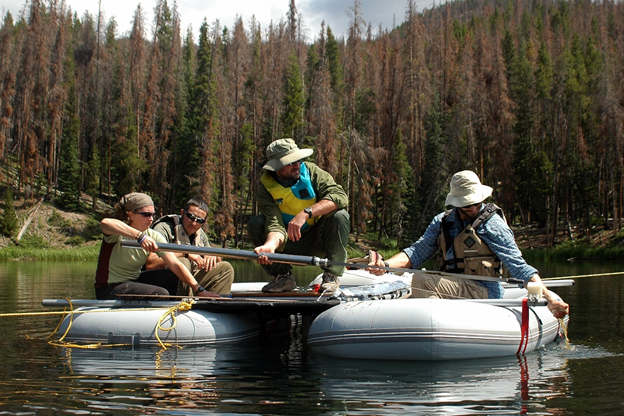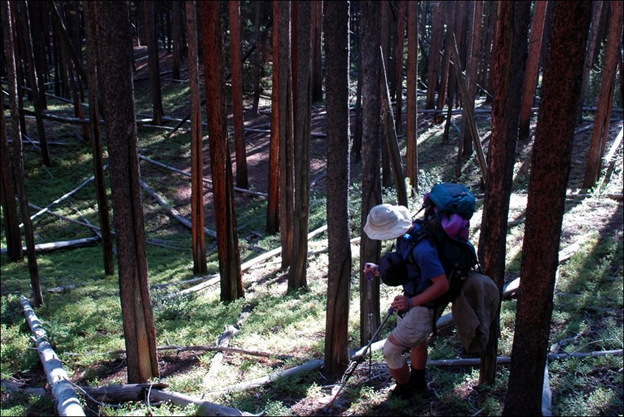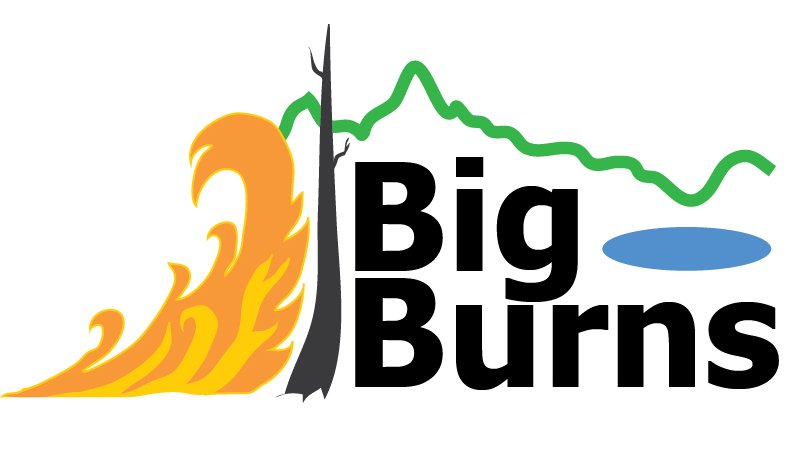1/7 Past 48 hr have been extraordinary for those living through #EastTroublesomeFire & observing from afar. My heart goes out to impacted communities, fire fighters & responders keeping people safe. From #fireecology perspective there& #39;s reason 4 hope for @RockyNPS #ColoradoFires
2/7 As of this AM, #EastTroublesomeFire fire burned just 1-mile south of a beloved research site @RockyNPS (that is/was "overdue" for fire): Chickaree Lake, where we have a 6000+ yr record of  https://abs.twimg.com/emoji/v2/... draggable="false" alt="🔥" title="Feuer" aria-label="Emoji: Feuer"> & ecosystem history, developed from lake sediments. #paleoecology
https://abs.twimg.com/emoji/v2/... draggable="false" alt="🔥" title="Feuer" aria-label="Emoji: Feuer"> & ecosystem history, developed from lake sediments. #paleoecology
3/7 Chickaree Lk., in @RockyNPS, is surrounded by lodgepole pine, much killed by mt pine beetle c. 2008-10. Based on tree-ring work by Jason Sibold @ThomasTVeblen et al., the area last experienced stand-replacing  https://abs.twimg.com/emoji/v2/... draggable="false" alt="🔥" title="Feuer" aria-label="Emoji: Feuer">in 1782, w/ some surface Fire in 1872 #dendrochronology
https://abs.twimg.com/emoji/v2/... draggable="false" alt="🔥" title="Feuer" aria-label="Emoji: Feuer">in 1782, w/ some surface Fire in 1872 #dendrochronology
4/7 Based on a 4000+ yr charcoal-derived #firehistory record developed by Paul Dunnette, the area experienced  https://abs.twimg.com/emoji/v2/... draggable="false" alt="🔥" title="Feuer" aria-label="Emoji: Feuer">(red dots) on avg. every 125 yr. Hence, 238 yr since stand-replacing Fire, Chickaree Lake has been "overdue" or at least expected to burn. https://nph.onlinelibrary.wiley.com/doi/full/10.1111/nph.12828">https://nph.onlinelibrary.wiley.com/doi/full/...
https://abs.twimg.com/emoji/v2/... draggable="false" alt="🔥" title="Feuer" aria-label="Emoji: Feuer">(red dots) on avg. every 125 yr. Hence, 238 yr since stand-replacing Fire, Chickaree Lake has been "overdue" or at least expected to burn. https://nph.onlinelibrary.wiley.com/doi/full/10.1111/nph.12828">https://nph.onlinelibrary.wiley.com/doi/full/...
5/7 Chickaree Lk. ecosystem has been #resilient to  https://abs.twimg.com/emoji/v2/... draggable="false" alt="🔥" title="Feuer" aria-label="Emoji: Feuer">for 6000+ yr., consistently recovering. This impressive resilience is typical of lodgepole pine forests in the past, even over periods of #climatechange. Some reasons for hope. https://iopscience.iop.org/article/10.1088/1748-9326/11/12/125003">https://iopscience.iop.org/article/1...
https://abs.twimg.com/emoji/v2/... draggable="false" alt="🔥" title="Feuer" aria-label="Emoji: Feuer">for 6000+ yr., consistently recovering. This impressive resilience is typical of lodgepole pine forests in the past, even over periods of #climatechange. Some reasons for hope. https://iopscience.iop.org/article/10.1088/1748-9326/11/12/125003">https://iopscience.iop.org/article/1...
6/7 A high-resolution pollen record by @prairiebear18 shows veg. recovery around Chickaree after https://abs.twimg.com/emoji/v2/... draggable="false" alt="🔥" title="Feuer" aria-label="Emoji: Feuer">over past 2500 yr. BIG question many will study is if & how recovery from #EastTroublesomeFire will differ from past, given rates of ongoing #climatechange https://journals.sagepub.com/doi/10.1177/0959683620941068">https://journals.sagepub.com/doi/10.11...
https://abs.twimg.com/emoji/v2/... draggable="false" alt="🔥" title="Feuer" aria-label="Emoji: Feuer">over past 2500 yr. BIG question many will study is if & how recovery from #EastTroublesomeFire will differ from past, given rates of ongoing #climatechange https://journals.sagepub.com/doi/10.1177/0959683620941068">https://journals.sagepub.com/doi/10.11...
7/7 The #BigBurns project is studying causes and impacts of past & future  https://abs.twimg.com/emoji/v2/... draggable="false" alt="🔥" title="Feuer" aria-label="Emoji: Feuer">through #paleoecology & ecosystem modeling in CO & N. Rockies in MT and ID, w/ @tarahudiburg @WyClimate Kendra McLauchlan @kribartowitz @Kyra_DWolf @prairiebear18 @meredith_parish D. Pompeani #NSFFunded
https://abs.twimg.com/emoji/v2/... draggable="false" alt="🔥" title="Feuer" aria-label="Emoji: Feuer">through #paleoecology & ecosystem modeling in CO & N. Rockies in MT and ID, w/ @tarahudiburg @WyClimate Kendra McLauchlan @kribartowitz @Kyra_DWolf @prairiebear18 @meredith_parish D. Pompeani #NSFFunded
And a bonus, for lakes at higher elevation in @RockyNPS, where  https://abs.twimg.com/emoji/v2/... draggable="false" alt="🔥" title="Feuer" aria-label="Emoji: Feuer"> is slightly more rare, estimated to have burned on average once every 300 years (but ranging from as short as 30 yr). https://besjournals.onlinelibrary.wiley.com/doi/full/10.1111/1365-2745.12296">https://besjournals.onlinelibrary.wiley.com/doi/full/...
https://abs.twimg.com/emoji/v2/... draggable="false" alt="🔥" title="Feuer" aria-label="Emoji: Feuer"> is slightly more rare, estimated to have burned on average once every 300 years (but ranging from as short as 30 yr). https://besjournals.onlinelibrary.wiley.com/doi/full/10.1111/1365-2745.12296">https://besjournals.onlinelibrary.wiley.com/doi/full/...

 Read on Twitter
Read on Twitter & ecosystem history, developed from lake sediments. #paleoecology" title="2/7 As of this AM, #EastTroublesomeFire fire burned just 1-mile south of a beloved research site @RockyNPS (that is/was "overdue" for fire): Chickaree Lake, where we have a 6000+ yr record of https://abs.twimg.com/emoji/v2/... draggable="false" alt="🔥" title="Feuer" aria-label="Emoji: Feuer"> & ecosystem history, developed from lake sediments. #paleoecology">
& ecosystem history, developed from lake sediments. #paleoecology" title="2/7 As of this AM, #EastTroublesomeFire fire burned just 1-mile south of a beloved research site @RockyNPS (that is/was "overdue" for fire): Chickaree Lake, where we have a 6000+ yr record of https://abs.twimg.com/emoji/v2/... draggable="false" alt="🔥" title="Feuer" aria-label="Emoji: Feuer"> & ecosystem history, developed from lake sediments. #paleoecology">
 & ecosystem history, developed from lake sediments. #paleoecology" title="2/7 As of this AM, #EastTroublesomeFire fire burned just 1-mile south of a beloved research site @RockyNPS (that is/was "overdue" for fire): Chickaree Lake, where we have a 6000+ yr record of https://abs.twimg.com/emoji/v2/... draggable="false" alt="🔥" title="Feuer" aria-label="Emoji: Feuer"> & ecosystem history, developed from lake sediments. #paleoecology">
& ecosystem history, developed from lake sediments. #paleoecology" title="2/7 As of this AM, #EastTroublesomeFire fire burned just 1-mile south of a beloved research site @RockyNPS (that is/was "overdue" for fire): Chickaree Lake, where we have a 6000+ yr record of https://abs.twimg.com/emoji/v2/... draggable="false" alt="🔥" title="Feuer" aria-label="Emoji: Feuer"> & ecosystem history, developed from lake sediments. #paleoecology">
 in 1782, w/ some surface Fire in 1872 #dendrochronology" title="3/7 Chickaree Lk., in @RockyNPS, is surrounded by lodgepole pine, much killed by mt pine beetle c. 2008-10. Based on tree-ring work by Jason Sibold @ThomasTVeblen et al., the area last experienced stand-replacing https://abs.twimg.com/emoji/v2/... draggable="false" alt="🔥" title="Feuer" aria-label="Emoji: Feuer">in 1782, w/ some surface Fire in 1872 #dendrochronology" class="img-responsive" style="max-width:100%;"/>
in 1782, w/ some surface Fire in 1872 #dendrochronology" title="3/7 Chickaree Lk., in @RockyNPS, is surrounded by lodgepole pine, much killed by mt pine beetle c. 2008-10. Based on tree-ring work by Jason Sibold @ThomasTVeblen et al., the area last experienced stand-replacing https://abs.twimg.com/emoji/v2/... draggable="false" alt="🔥" title="Feuer" aria-label="Emoji: Feuer">in 1782, w/ some surface Fire in 1872 #dendrochronology" class="img-responsive" style="max-width:100%;"/>
 (red dots) on avg. every 125 yr. Hence, 238 yr since stand-replacing Fire, Chickaree Lake has been "overdue" or at least expected to burn. https://nph.onlinelibrary.wiley.com/doi/full/..." title="4/7 Based on a 4000+ yr charcoal-derived #firehistory record developed by Paul Dunnette, the area experienced https://abs.twimg.com/emoji/v2/... draggable="false" alt="🔥" title="Feuer" aria-label="Emoji: Feuer">(red dots) on avg. every 125 yr. Hence, 238 yr since stand-replacing Fire, Chickaree Lake has been "overdue" or at least expected to burn. https://nph.onlinelibrary.wiley.com/doi/full/..." class="img-responsive" style="max-width:100%;"/>
(red dots) on avg. every 125 yr. Hence, 238 yr since stand-replacing Fire, Chickaree Lake has been "overdue" or at least expected to burn. https://nph.onlinelibrary.wiley.com/doi/full/..." title="4/7 Based on a 4000+ yr charcoal-derived #firehistory record developed by Paul Dunnette, the area experienced https://abs.twimg.com/emoji/v2/... draggable="false" alt="🔥" title="Feuer" aria-label="Emoji: Feuer">(red dots) on avg. every 125 yr. Hence, 238 yr since stand-replacing Fire, Chickaree Lake has been "overdue" or at least expected to burn. https://nph.onlinelibrary.wiley.com/doi/full/..." class="img-responsive" style="max-width:100%;"/>
 for 6000+ yr., consistently recovering. This impressive resilience is typical of lodgepole pine forests in the past, even over periods of #climatechange. Some reasons for hope. https://iopscience.iop.org/article/1..." title="5/7 Chickaree Lk. ecosystem has been #resilient to https://abs.twimg.com/emoji/v2/... draggable="false" alt="🔥" title="Feuer" aria-label="Emoji: Feuer">for 6000+ yr., consistently recovering. This impressive resilience is typical of lodgepole pine forests in the past, even over periods of #climatechange. Some reasons for hope. https://iopscience.iop.org/article/1..." class="img-responsive" style="max-width:100%;"/>
for 6000+ yr., consistently recovering. This impressive resilience is typical of lodgepole pine forests in the past, even over periods of #climatechange. Some reasons for hope. https://iopscience.iop.org/article/1..." title="5/7 Chickaree Lk. ecosystem has been #resilient to https://abs.twimg.com/emoji/v2/... draggable="false" alt="🔥" title="Feuer" aria-label="Emoji: Feuer">for 6000+ yr., consistently recovering. This impressive resilience is typical of lodgepole pine forests in the past, even over periods of #climatechange. Some reasons for hope. https://iopscience.iop.org/article/1..." class="img-responsive" style="max-width:100%;"/>
 through #paleoecology & ecosystem modeling in CO & N. Rockies in MT and ID, w/ @tarahudiburg @WyClimate Kendra McLauchlan @kribartowitz @Kyra_DWolf @prairiebear18 @meredith_parish D. Pompeani #NSFFunded" title="7/7 The #BigBurns project is studying causes and impacts of past & future https://abs.twimg.com/emoji/v2/... draggable="false" alt="🔥" title="Feuer" aria-label="Emoji: Feuer">through #paleoecology & ecosystem modeling in CO & N. Rockies in MT and ID, w/ @tarahudiburg @WyClimate Kendra McLauchlan @kribartowitz @Kyra_DWolf @prairiebear18 @meredith_parish D. Pompeani #NSFFunded" class="img-responsive" style="max-width:100%;"/>
through #paleoecology & ecosystem modeling in CO & N. Rockies in MT and ID, w/ @tarahudiburg @WyClimate Kendra McLauchlan @kribartowitz @Kyra_DWolf @prairiebear18 @meredith_parish D. Pompeani #NSFFunded" title="7/7 The #BigBurns project is studying causes and impacts of past & future https://abs.twimg.com/emoji/v2/... draggable="false" alt="🔥" title="Feuer" aria-label="Emoji: Feuer">through #paleoecology & ecosystem modeling in CO & N. Rockies in MT and ID, w/ @tarahudiburg @WyClimate Kendra McLauchlan @kribartowitz @Kyra_DWolf @prairiebear18 @meredith_parish D. Pompeani #NSFFunded" class="img-responsive" style="max-width:100%;"/>


